 Reading Time: 8 minutes
Reading Time: 8 minutesGoogle rolled out eight major algorithm updates in 2022. Those included core updates, product review updates, and others intended to help with search relevance, combating spam, and their overall user experience. If you’re fairly new to Search Engine Optimization (SEO), you may be asking:
- What are those updates?
- How do the updates affect my site’s traffic and goals?
- If my site is impacted, how do I recover?
- How do I avoid being impacted in future?
It can be challenging to answer all those questions and know how to update your content strategy, which is why we have created this mini-guide for you.
List of Algorithm Updates
Google makes many changes to their algorithms, but most changes go unnoticed. Google doesn’t usually publish much information about those changes. However, when there is a major update that will impact a lot of sites, Google does publish a little information about the update on their webmaster support page. Below is a recap of the algorithm updates for 2022.
Here are the eight Google algorithm updates of 2022:
| Algorithm Update | Time Frame | Description/Purpose |
| Google Page Experience Update for Desktop | January, February 2022 | UX is not just about content but other factors like page speed as well |
| Google Product Review Updates | March, July, September 2022 | Authentic product reviews that don’t just plug in products without credible product information |
| Google Helpful Content Update | August 2022 | You must not use unhelpful content or irrelevant content to pad site content |
| Google Search Core Updates | May, September 2022 | You must create content for the user first, search engine later |
| Google Search Spam Update | October, December 2022 | Spam guidelines, both for malware and content spam |
As you can see, some types of algorithms were updated multiple times in 2022, so we need to pay special attention to those as we infer that the basis of the update aligns to Google’s vision of how they wish to improve the quality of search results, the types of sites, and the content they want to show.
Google Algorithm Updates Explained
Let’s look at each of the updates one at a time:
Google Page Experience Update for Desktop
(January, February 2022)
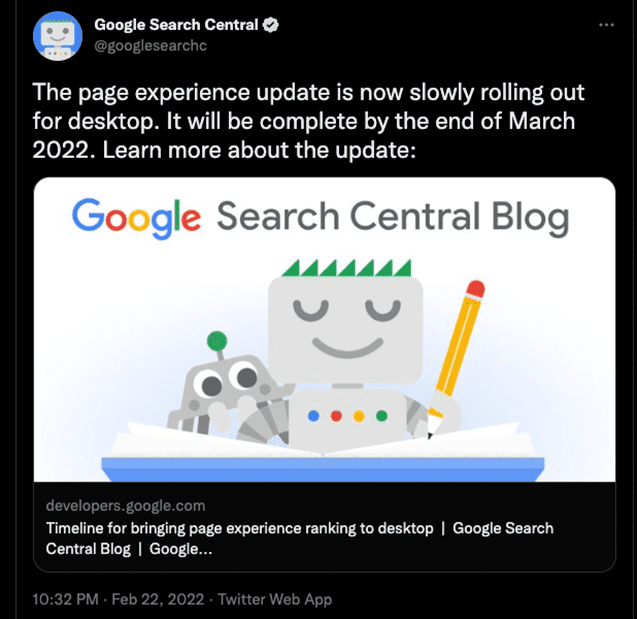
Source: @googlesearchc
This update relates to non-content-related parameters contributing to a user’s page experience. The update includes core web vitals, a set of metrics to assess user experience. They look at:
- Load performance
- Responsiveness to user input
- Layout stability
- First input delay
You should also consider checking for mobile screen compatibility and whether your site connection is secure as Google incorporates page speed signals into their ranking algorithms. Google provides helpful resources to help you optimize your page experience.
(March, July, September 2022)
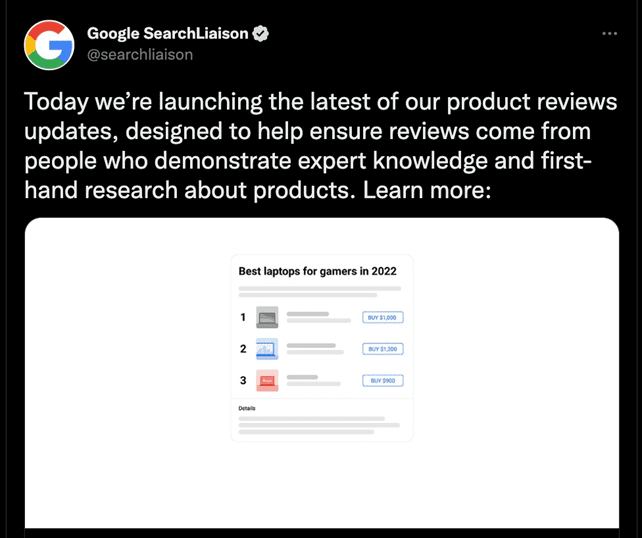
Source: @searchliaison
The three-product review algorithm updates target content written about products. Google wants to weed out product information that is redundant because it doesn’t:
- Display expert knowledge or original information
- Show what the product is like physically and how a customer is supposed to use the product
- Adequately discuss the benefits and drawbacks of the product, or compare it with comparable products
- Provide visual explanations of the product in the form of tutorial videos or images
- Include multiple sellers so a reader has choices from whom they want to buy
Google also wants product review websites to give evidence as to why they are recommending a particular product as the “best” product. They want users to have access to high-quality ranking lists that help them decide which product to buy based on first-hand information about the product.
The goal is for product review websites to enhance a user’s shopping experience with best practices that Google has carved across multiple updates. Google periodically provides helpful tips to achieve that goal.
(May, September 2022)
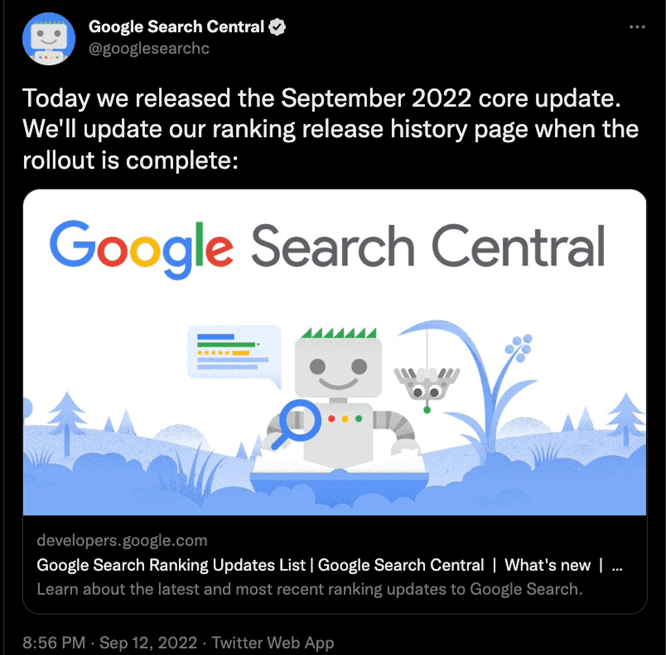
Source: @googlesearchc
These are broad changes to Google’s search algorithms that can impact many sites. These updates don’t target specific sites or practices like spam or product review updates. Instead, they focus on the content assessment parameters Google uses to determine relevance and how they can rank pages in search results. This can result in some pages to drop or gain in rankings .
You can go through your website content to ensure it meets user search intent and audience relevance. Content should help users by providing first-hand knowledge. That will help you recover from drops in ranking based on such updates.
You can do a quality audit using questions Google has provided as markers of helpful content. Some of those questions include:
- Does the content include original information based on research and analysis?
- Is the content comprehensive?
- Does it provide information beyond the obvious?
- Is it a mere duplication of content from other sources, or does it draw from other sources while adding original takes?
- Does the heading provide a helpful summary of the content without being an exaggeration or clickbait? Are the heading tags and title tags correct?
You should also consider a content reaudit based on whether the information is solely for the search engine (it should not be) and other production questions, such as stylistic/grammar issues, readability issues, mobile device compatibility, etc.
(August 2022)
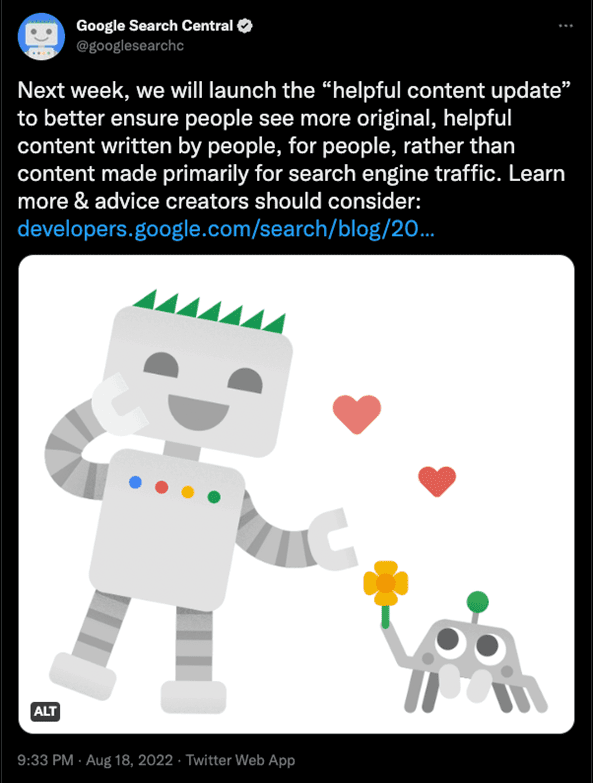
Source: @googlesearchc
This category of updates focuses on identifying unhelpful content that does not provide a satisfying experience for the user. It’s designed to look for AI and system generated content that’s built solely for search engines and not for people. The automated ranking systems of Google identify low-value content and classifies that site, or page, as having unhelpful content.
Note: This algorithm is based on a machine learning model, so it can compete with other parameters that might determine the same information as high-value.
If you see your site is affected by such an update, revert to a content assessment you would do for a core update and improve your content accordingly. You may need to rethink your content strategy if it involves a lot of AI generated content.
(October, December 2022)
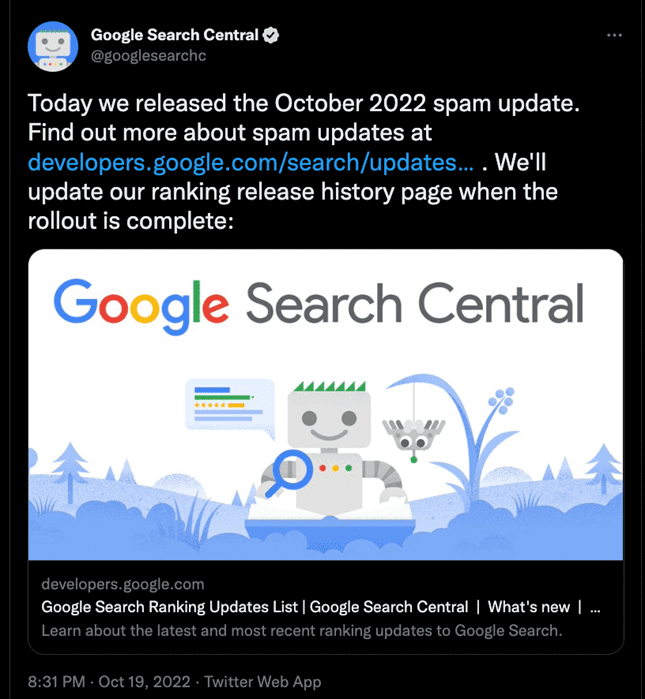
Source: @googlesearchc
Google uses the spam updates to discover and remove pages containing gibberish, deceptive, or malicious content, or sites that have been hacked. If your website saw a dip in traffic after the update was rolled out, then there is a possibility your content was removed from Google’s index, or demoted, because of weak site security.
Those downgrades can be caused by hacked content or malware. Google detects spam through automated software which they continue to improve. It’s also used to detect spam in business profiles, reviews, videos, and fake user accounts to name a few.
From an SEO perspective, you need to check whether or not your content engages in the following kinds of spam content:
Authentic link building and identifying toxic links will help with both spam content and malware content.
Key Takeaways for Your Content Strategy in 2023
Based on the above Google updates, here are the top three items you should prioritize for your content strategy in 2023:
- Prove Ownership
If you’re selling or promoting a product, you need to prove you have the product and can demonstrate personal knowledge about the item. That can be done by including the product’s details, packaging, setup, usage, or related accessories that might also be used in conjunction with the product. Your content needs to stand out and not be similar to what is printed on the packaging or can be found in the manufacturer’s product description.
If applicable, consider writing about other aspects of the product that can help potential buyers understand its history, such as where the item might fall in line within the manufacturer’s range of products and its competition.
If possible, we also recommend you take photographs and videos of your own product, rather than using stock images. We understand that might not be scalable for large ecommerce sites, so consider focusing on a set of priority products. Include a series of images with different angles and closeups to show product details that might be important.
If you create videos, be sure to take advantage of Google’s video indexing report because they can boost your chances of gaining exposure in the search results.
- Show Your Expertise
Showing your expertise refers to the authoritative nature of the content you are producing. When you base your information on expert takeaways, Google algorithms are less likely to mark the information as spam or unhelpful.
Ensure that your website content is high-quality based on:
- Original research with transparent sourcing, evidence, and context
- Insights from authorities in the relevant field, whether those are your internal subject matter experts or external industry experts or enthusiasts
- Factually correct information that does not skew data or engage in confirmation bias
- Depth of knowledge that goes beyond basic Google searches. An example is a product review after actually using the product, rather than putting together a review based on others’ experiences of the product
- Use Schema Markup and Structured Data
Other than the eight updates listed above, Google rolls out updates to their Knowledge Panels every few weeks. Google uses a number of sources, such as Wikipedia, its own knowledge graph, as well as structured data on your website to help build that information.
Here’s an example:
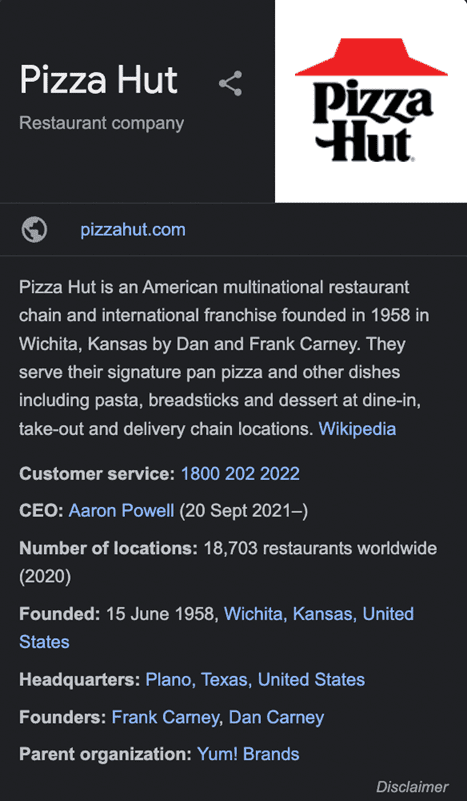
Google associates related topics through entities and topics. When Google has a comprehensive database of information about a topic, it can use that as a reference point to gauge the value of search results on those topics.
As you can see in the example above, Google has gathered data points that users commonly look for related to the primary search term “Pizza Hut.”
You can help Google by adding the following items in your schema markup:
Your Company:
- Company name
- Address
- Phone number
- Latitude and longitude
- Logo URL
- Company description
- Website
- Social media profile pages
Your Products
- Name
- Description
- SKU
- GTIN
- Brand
- Price
- Offers
- Shipping
- Image
- Availability
- Ratings
- Reviews
Other popular schemas you can add include:
- Article
- Breadcrumb
- Events
- Frequently asked questions (FAQ)
- How-to
- Sitelinks search box
Google has thirty-two guides for the most popular types of schema in their help document: Understand How Structured Data Markup Works.
Google recommends using the JSON-LD format, which we also recommend, because it tends to be easier to implement and modify than microdata or RDFa. Also, because JSON-LD is in a separate code block to the HTML, unlike microdata and RDFa, there’s less likelihood any HTML or template updates will affect the syntax and Google’s ability to parse the schema correctly.
Once the schema has been added to your site, we also recommend using Google’s rich snippets testing tool. Google Search Console also uses the same engine, whereas we’ve found the schema validator tool can sometimes show your markup is correct, only to be then flagged as unparsable by Google Search Console.
If you wish to incorporate these takeaways into your 2023 content strategy, you will need to work with both the content production team and your developers to make that happen. They will need to be educated and given guidelines about how to build a site that can make it through future algorithm updates and continue to grow organic traffic. Feel free to link to or share this article with your internal teams as a primer. If you need help assessing and updating your content strategy, please contact us; we’d be happy to start a discussion with you.




